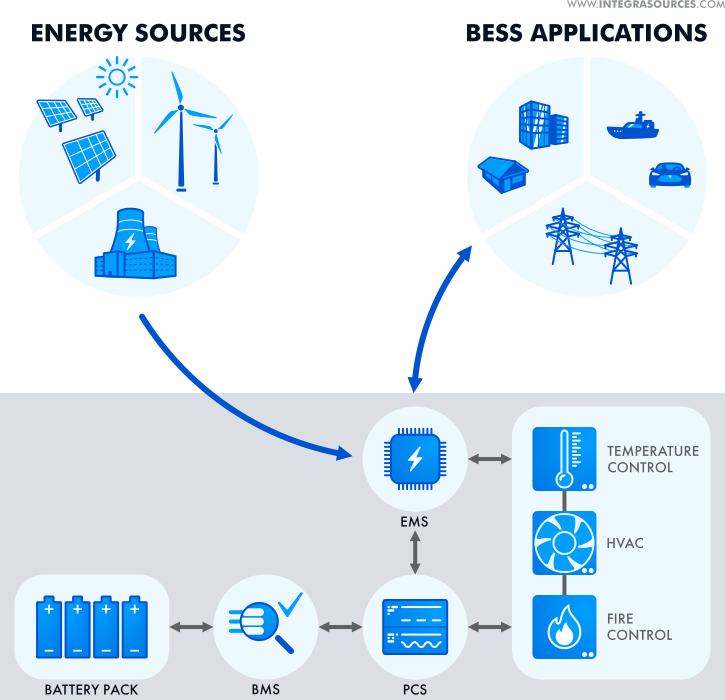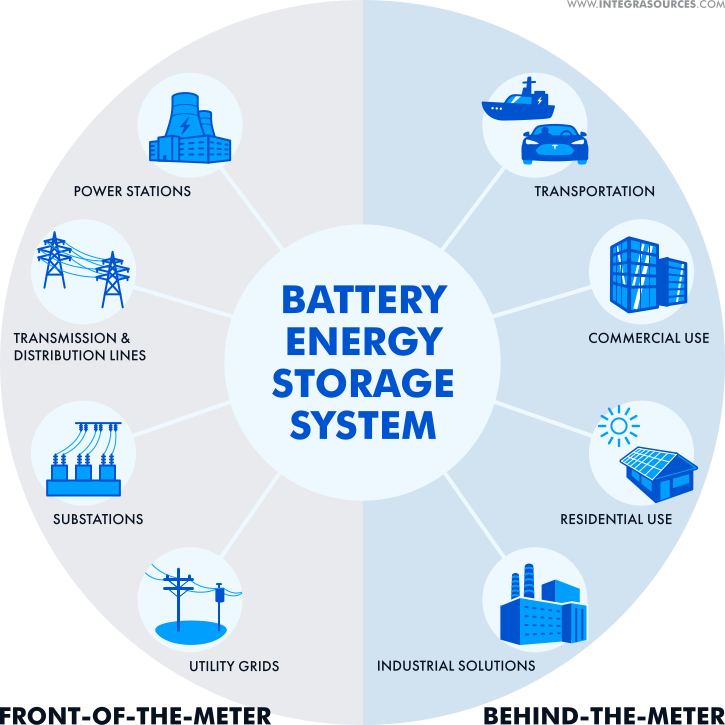What is BESS?
A battery energy storage system (BESS) is a complex solution that utilizes rechargeable batteries to store energy for later use. The type of BESS is related to the electrochemistry or the battery it employs; such systems can employ lithium-ion, lead-acid, nickel-cadmium, sodium-sulfur, and flow batteries. Energy Storage Systems (ESS) is a broader term that may rely on a variety of technologies other than batteries, such as hydroelectricity, flywheels, compressed air, and more.
Structure and core elements of BESS
To understand what a BESS is and how it works, it helps to learn about its structure and core elements:

Typical BESS structure. (Image source: Integra Sources LLC)
Battery
Electrical energy supplied from different sources such as solar, wind or power stations is converted into chemical energy during battery charging. The energy released by batteries during discharge can power homes, vehicles, commercial buildings and the grid. The battery is composed of battery cells, which can be arranged to form battery modules, battery packs and battery boxes.
Battery Management System (BMS)
The BMS provides assurance for the safe and correct operation of the battery. Each type of battery has specific charging and discharging conditions. The BMS ensures that the battery remains within the required current, voltage and temperature ranges. A BMS monitors the battery’s parameters and estimates its remaining capacity (SOC) and state of health (SOH), ensuring reliable and long-lasting battery performance.
Power Conversion System (PCS)
BESS uses a power conversion system that converts direct current (DC) into alternating current (AC) and vice versa. When the battery is charging, alternating current flows from the power source and is converted to direct current. As the battery discharges, it generates DC power, which is converted back to AC power for the BESS application.
Electric Energy Management System (EMS)
EMS is a control unit of the battery energy storage system. The EMS manages the power available in the BESS, i.e. when, why and in what amount it is accumulated or released. EMS combines the individual elements of the BESS and optimizes its overall performance.
Security System
There can be a series of security systems, each responsible for a specific task. For example, the HVAC system keeps the BESS at the desired temperature and humidity through HVAC. Fire protection systems can detect smoke and prevent fire accidents.
What an BESS do?
Every year, battery energy storage systems provide electricity to thousands of homes, businesses, factories and communities around the world. These systems vary in size and energy storage capacity.
For example, the Tesla Powerwall has a usable capacity of 13.5 kWh, a compact device that can provide uninterrupted power to a home. And the total capacity of the Vistra Moss Landing Energy Storage Facility reaches 1,600 MWh, which is the largest BESS in the world and can provide electricity for 300,000 homes.
Despite differences in size and capacity, BESSs can achieve similar functions and solve similar problems. Let’s take a look at a case where battery energy storage can come in handy.
Renewable Energy Integration
BESS can effectively use solar and wind energy at any time and in any weather. Rechargeable batteries can store excess energy generated by intermittent renewable sources. These energies can then be dispatched according to the needs of the users.
When integrated with battery energy storage solutions, renewable energy can replace fossil fuels and provide cheap and clean energy for diverse applications. Renewable energy integration is widely used in:
Solar and wind farms
Off-grid and isolated communities (islands and hard-to-reach areas).
Home energy storage devices (such as Powerwalls) combined with solar panels.
In addition to supporting off-grid systems, BESS can substantially support on-grid and hybrid solutions for residential, commercial and industrial use.
Energy Arbitrage
There is a positive correlation between electricity demand and its cost. Electricity prices increase during times of peak demand and decrease when demand falls. Consumers can use batteries for energy arbitrage (aka time shifting).
Consumers can charge the battery at a low cost during off-peak hours and use the BESS to store the electricity. They can then wait until electricity prices increase to discharge the battery to use lower-cost electricity or sell it to the grid.
As a result, households and businesses can efficiently manage power resources and cut costs.
Load Management
The consumption of electricity varies throughout the day and also varies with seasons, so there are peak hours and non-peak hours. BESS allows users to freely adjust power consumption during these times and save electricity costs.
Power peak shaving is one of the most common use cases for BESS load management, which focuses on reducing power consumption during peak hours. In addition, consumers can reduce their electricity bills through energy arbitrage.
Battery energy storage solutions help avoid peak loads on the grid and therefore avoid blackouts and other emergencies. By releasing stored energy, BESS can reduce the load on the grid and keep the power supply uninterrupted.
Black-Start Capacity
BESS can assist power stations and grids to quickly restore power after a power outage. Consumers can use battery energy storage systems instead of diesel generators, which are a lower cost and more energy-efficient black start solution. BESS operates independently of grid transmission lines and delivers power when needed, from minutes to hours.
Backup Power
BESS provides power to homes, businesses, and other facilities to keep them running. This is critical for healthcare facilities and other organizations providing health and safety-related services. Depending on the energy storage capacity, BESS can provide backup power for as long as needed, even in the event of a severe grid failure.
Frequency and Voltage Control
If the power supply is not synchronous to meet its actual needs, the frequency and voltage may exceed its operating limits. This can lead to loss of power and blackouts. BESS can ensure the stability of the grid and power system by adjusting voltage and frequency. Due to the fast reaction time of battery energy storage systems, they can be an effective grid-balancing solution.
Microgrid
These mini-grids, when connected to a larger grid, supply electricity to commercial buildings, manufacturing plants, or communities. Autonomous microgrids can provide electricity to remote areas and communities such as islands. When combined with BESS and integrating renewable energy, the microgrid can serve as a resilient power system for multiple users.
Transmission and Distribution Delays
Transmission and distribution (T&D) lines are prone to aging and depreciation due to peak loads and congestion. Battery storage solutions can act as a T&D asset to address this issue. BESS provides additional energy storage capacity and balances loads, thereby deferring upgrades to existing T&D lines and building new infrastructure, resulting in substantial savings.
Best Applications for BESS
BESS relies on affordable technologies such as lithium-ion batteries, whose prices have fallen by nearly 90% over the past ten years and will fall further. Battery energy storage solutions are available in a wide range of configurations, offering different storage capacities and sizes, making them suitable for many industries and applications.
These applications can be divided into front-of-the-meter (FTM) applications, which are utility-scale systems (where power consumed is measured by a meter), and behind-the-meter (BTM) applications, which provide power for on-site use (power consumed cannot be connected to a network and therefore cannot be measured by an ammeter). Below is a list (obviously not a complete list) of BESS applications for FTM and BTM.

BESS application (Image source: Integra Sources LLC)
FTM Applications
For the operation and maintenance of utility-scale facilities and equipment, battery energy storage systems can make a considerable contribution. BESS provides reserved capacity and black start services, enabling voltage and frequency stability and saving money by deferring maintenance. FTM BESS applications include:
Public Power Grid
Substation
Power Transmission and Distribution Lines
Power Station
BTM Applications
The BTM system can bypass the grid to supply electricity to consumers. Together with green energy, BESS sustainably supports stand-alone power systems or microgrids. Manufacturers can use battery energy storage to store backup power to avoid downtime in production facilities. Businesses and households can use BESS to drastically reduce electricity bills through time shifting of energy. BTM battery energy storage system can be used for the following purposes:
Industrial and Manufacturing Plants
Enterprise
Family
Electric Car
Marine System
Does it make sense to build a BESS?
The answer is yes. If you want to answer in detail, some clarification is needed.
No doubt buying a ready-made BESS saves a lot of time and sometimes a lot of money. If there are no special requirements for the system, out-of-the-box solutions can be selected from a large number of energy storage products on the market. Even so, several reasons may deter consumers from purchasing, including:
Specific customer requirements, including business segment requirements and working conditions
Lack of required functionality or unnecessary functionality increases the cost of the system
The system is incomplete and lacks supporting equipment
Low software quality
No warranty and post-warranty maintenance
Setting up a battery storage system can be a tedious process that requires time, money, and expertise. But then there is an opportunity to create a highly customized solution that fully meets all the needs of the end user.
A good BESS can provide better functionality, usability, security, and network security. Implementing advanced BMS algorithms will allow the user to improve the performance of the battery and extend its lifespan. Developing custom solutions optimizes technical support, customer service, and other services required by end users or BESS suppliers.
BBIER®, Professional Commercial LED Lighting Manufacturer & Company & Supplier & Factory, Supplying:LED Dock Lights suppliers, Canopy Lights suppliers, Corn Bulbs suppliers, Gas Station Lights suppliers, Grow Lights suppliers, Linear Lights suppliers, Temporary Lights suppliers , UFO High Bay Lights suppliers, Explosion Proof Lights suppliers, Flood Lights suppliers, Garden Lights suppliers, Post Top Lights suppliers, Parking lot lights suppliers, Shoebox Lights suppliers, Sport Lights suppliers, Stadium Lights suppliers, Street Lights suppliers, Wall Pack Lights suppliers, Solar Post Top Lights suppliers, Solar Street Lights suppliers, Classroom Lights suppliers, Emergency Lights suppliers, Exit Signs suppliers, LED Ceiling Fans suppliers,etc. We have over 13 years of commercial lighting R&D experience, 50+ LED lights patents, 200+ LED Lights Certifications, Support OEM & ODM, 5 Years Warranty.

